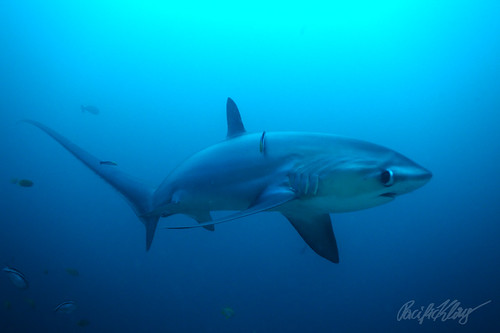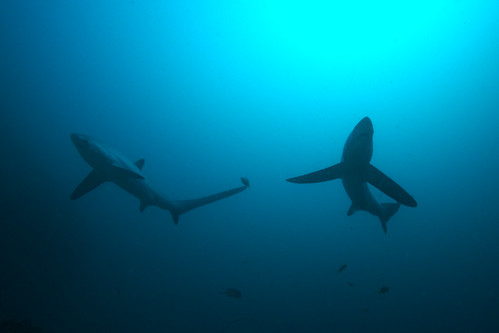Pacificklaus Island Review: Malapascua
Some of the larger Philippine islands, like Luzon or Mindanao, are real mini-continents. They have mountains rising over 3000 meters, river systems and several linguistic groups among their inhabitants. Some of their interiors are covered in dense jungle. Several of the bigger islands have populations in the millions, and on the island of Luzon lies Manila, one of Asia’s most gigantic metropolises.
But the island of Malapascua is just a tiny speck of sand in the ocean, with a few thousand people living on it. On it’s shores, you feel to be on land, but in the ocean at the same time. Located just north of the larger island of Cebu, it was put on the diving map by the thresher sharks at nearby Monad Shoal. These amazing deep-water sharks regularly visit (= every day) the cleaner stations at diveable depths. I have never seen sharks so elegant and such powerful swimmers. It’s a special experience to encounter them on a plateau in the middle of the ocean in the gloomy light just after sunrise (that’s when they tend to show up most).

But the macro marine life is also highly spectacular. This is a place where I have counted 59 different species of gobies, and found some other really unusual small fishes, unusual shrimp and nudibranchs. The sea urchins are particularly worth checking out, as they are the home of urchin shrimp, zebra crabs and clingfish. This is an odd special of Malapascua diving, tiny sea urchin inhabitants!
The house reef in front of Evolution diving is a sandy dive site with it’s share of dragonets, frogfish crabs, unusual anemones with their shrimp inhabitants, and mating cardinalfish in the cracks of the sunken dive boats found there. Diving this “house reef” (house muck would be a better term) is like an Easter egg hunt for rare and unusual animals.
Within day trip distance of Malapascua are the uninhabited, superbly diveable islands of Gato and Kalangaman. Underneath Gato is a swim-through, with a white-tip reef shark often waiting at one end of the tunnel. The walls of the island are covered in beautiful red soft corals, and sea snakes are regularly encountered during dives at Gato. Kalangaman, half-way between Cebu and Leyte, is another great diving location with walls alive with corals and fishes.
Most of the resorts are lined up on a white sand beach facing south, with a view of the mountains of Leyte on the horizon. The tourism intensity is at somewhat of a sweet spot – enough places to eat good food and drink cocktails at sunset, but no nasty crowds. There are still enough places where you can sit on the beach and appreciate the sunset by yourself, but also plenty of spots to mix & socialize. You can get a coconut-oil massage on the beach after your dive to get rid of some of the nitrogen in your body. And you are quite likely to run into some interesting people – most folks who make the effort to go to a small, hot, relatively remote island to see elusive sharks at 6am are pretty cool. Happy days!
Dive and stay with: Definitely Evolution Diving. This is the place where I did most of my technical diving training, with owners Matt Reed and David Joyce. These guys are also big on responsible/environmentally conscious diving. Evolution’s restaurant/bar, the Craic House (Craic is Irish-Gaelic for “fun”) is a chill social place where I have met many interesting people.
Getting there: A 3-4 hour car ride from Cebu City/Mactan International Airport, followed by a 20 minute boat ride from Maja in the north of Cebu. You can get a car with a driver (all dive shops can organize that), or take the bus; Once in Maja you can also take a public boat or have the dive shop boat wait for you. Occasionally, during the typhoon season late in the year the sea is too rough to cross on a banka to Malapascua, then you’ll have to wait for a day or so in Maja.
Pacificklaus Island Rating: 4.837 out of 5 gobies.
